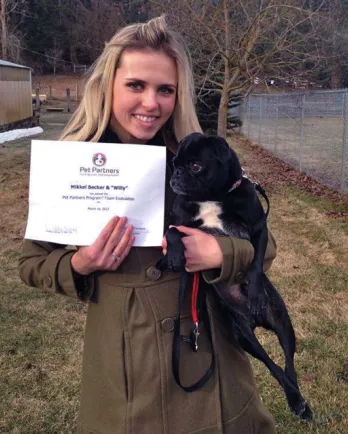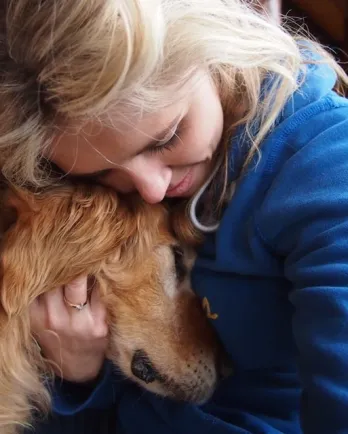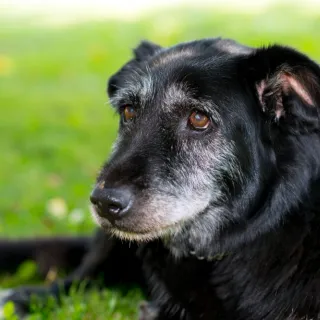Training as an Investment of Love: An Interview with Mikkel Becker
The Grey Muzzle Organization is proud to have trainer Mikkel Becker as a member of its Advisory Board. A graduate of prestigious dog-training programs, Mikkel Becker not only provides positive and non-force training strategies to her clients, but also shares her sought-after advice as contributing author to a variety of magazines and newspapers and is a regular featured trainer on television. As resident trainer for Vetstreet.com, Mikkel offers articles and training videos focusing on common training questions, training and pet health, and solutions to behavioral issues. You can see our earlier post for links to some of her recent Vetstreet.com articles on training older dogs. She has also collaborated with her father, veterinarian and fellow Grey Muzzle Advisory Board member Dr. Marty Becker, on projects such as creating strategies for fear-free vet visits. In addition to supporting Grey Muzzle, her work on behalf of shelter animals includes evaluating shelter dogs for the National Disaster Search Dog Foundation and serving as a behavior consultant at Homeward Pet Animal Adoption Center in Woodinville, Washington. She lives in the Seattle area with her husband, Ben; daughter, Reagan; and Pugs, Willy and Bruce.
To our delight, when we asked Mikkel for an interview, she jumped at the chance to tell us how wonderful training is for senior dogs and about the impact her dogs have had on her life, as well as answer some questions about common problems facing older dogs.
Mikkel, as a trainer, have you found a difference between working with older dogs as opposed to younger dogs?
There's an "aha" moment that happens during training when the puppy or dog gets what it is you're asking. They light up and get so excited and exuberant that they have finally figured out what brought their favorite reinforcer, a treat or a toy. But for senior dogs that are training for the first time or are learning something new, the moment is absolutely magical. It's easy for us to forget that senior dogs need ongoing training, even if they were already trained as a puppy or young adult, because training is good for their minds and reinforces desirable behavior, and the interaction brings them inexpressible joy.
I appreciate going into homes and working with senior dogs that haven't practiced or learned anything new for years—especially the dogs that have never been trained in their lives—and teaching them something new. It's gratifying to show that the old adage "old dogs can't learn new tricks" doesn't apply. People may believe in general that old dogs can still be trained, but sometimes when it comes to their own dog, I’ll have people outright tell me the dog is too old or too set in his ways. Really, it's that the person isn't believing in more for their dog, perhaps doesn't want to put in the effort to train for the change, or doesn't realize how incredibly amazing their dog's mind really is. When a dog all the sudden is doing five to ten new behaviors and tricks he's learned in a session, the results speak for what my words could only mildly convince.
One of my most unforgettable moments was with my own senior dog, Teddy. He was taken from a very abusive situation at about 10 years of age. We adopted him into our family, and right away I started training. He didn't know a single trick, so even "sit" was new. His "aha" moment came when I started to use the click to reinforce the very basics, sitting and lying down. His eyes lit up and I could see the joy all over his face and body when, for the first time, he understood the concept that he really did have the power to influence what happened to him. He saw he had a form of control over his life. And what’s more, the control he had was over even more good things coming to him. With the positive training, he thrived because the avoidance of force gave him safety and freedom from fear, but more so, he had a way to communicate and express himself that was finally understood.
For senior dogs, training gives them the ability to both understand and finally be understood. It's also an investment of love. For that reason, it can lead to that comeback or breakthrough moment we love to hear about in stories and movies. I get to see it in front of me when dogs make these incredible breakthroughs and epiphanies that impact their relationship with their people for the better and increase their confidence.
Training seems to be a lifelong endeavor for your Pugs, Bruce and Willy. Are there any new tricks that you have taught them recently? How do you keep them interested in learning new things?
It doesn't matter that I'm a trainer; I still take my dogs to training classes. For me, it's an important investment to sign up for one or two a year, with trainers I respect. Not so much for the information, but simply for the bonding and socialization that occur. Dogs love to be challenged and like to work, and this desire doesn't go away as they age.
For my Pug Willy, who is certified as a therapy dog, there is nothing like the incredible focus and attention he pays when he knows he's "working." For me, it's important to continue my dogs' training throughout their lifetimes for their own mental and emotional well-being. Plain and simple, it makes them happy, and it helps us maintain a tight bond. People often don't realize that senior dogs need ongoing socialization throughout their lives and not just in puppyhood. It's important to continue their training, take them on social outings, and invest in their mental and physical well-being. Otherwise, dogs can deteriorate mentally and develop behavioral challenges.
When I train, it's in this time that I really experience that "in the moment, forget all my problems" kind of thinking. It's just me and my dogs. The dogs know the difference between quality time and the times when we're distracted. So for them, it's an important investment that we care about them, we notice them, and we pay attention to all the good things they're doing; it's an expression of love.
With my Pugs, we train throughout the day. But at night, we have training sessions to practice new behaviors. The most recent tricks the Pugs have been practicing are their army crawls, where they move with their bellies on the floor, and their waves to say "hi" to someone new. We've also been rehearsing our “leave it” with a myriad of new items, so that regardless of whether one or ten things are dropped, or they come across something off-limits on the ground, they'll leave it alone. Thank goodness we've practiced these behaviors and keep rehearsing them. Recently we needed it when we were out on a walk and Bruce found this gigantic bun that I didn't see. I looked over and saw him just about to wolf it down whole and immediately told him "drop it!" Thankfully he spit out the entire bun. I was pretty amazed and grateful. We've had some situations where people have been poisoning dogs, so it was a relief to not have to worry about what my dog just ate.
I can't say enough how much I love my two dogs. They bring me so much joy and love, and I can’t ever repay the fullness they've put into my life. With my dogs, it's like a long-term friendship where I think back on the times they have been through with me and how they never left my side. They have been with me at my happiest and my saddest moments, and whether they've celebrated with me in the joy or they've licked away tears from my face, they're always there. One time I was going through a really difficult situation and was sobbing uncontrollably, in a way I don't know if I've ever done before or since. The Pugs took shifts sitting on my lap and licking me. They would alternate who would sit on my lap while the other sat waiting at my side, licking my arm, and looking up at me with concern. It was so amazing to feel their concern and to know that no matter what, I was so loved. God works in all ways, and for me, he has shown me undying love through my dogs. One of the reasons I enjoy training is that I can give back even a portion of love to the amazing creatures who have changed my life for the better.
You have written about the special bond that your adopted senior dog, Mr. Teddy, had with your daughter, Reagan, when she was just a toddler. How do you help a child successfully interact with dogs from such a young age?
Mr. Teddy was one of those unique dogs that just loved children. My parent's dog Quora, an adopted dog that's now a senior, is the same way. My Pug Willy is similar. (Reagan says Willy's her very best friend!) They naturally want to be near Reagan and sit on her lap or be next to her. Right as I'm typing this, Quora is up on Reagan’s lap licking her. She adores my little girl.
Not all dogs are gaga for children, though, and many are fearful, if they have had limited or negative experiences with kids. For this reason, it’s imperative to make children both safe and positive for dogs who come in contact with them. This means teaching the dogs to remain relaxed around children, giving them an exit strategy, and offering a break when they need it, as well as giving the child ground rules on how to interact. Most importantly, dogs should always be actively supervised by an adult when they are around a child.
For me, it's been really important to teach Reagan and supervise her on how to have the right interactions. I emphasize how to pet, how to let the dog approach first, and I continually guide and quiz her on the things to avoid (approaching a dog, hugging, kissing, grabbing, pulling). Having Reagan be a predictable child who is less threatening has been one of the most important things in their relationship. Reagan also has trained the dogs how to do things with treats. This teaches the dogs to listen to her and to associate her with being safe and a positive in their life.
Although Reagan is around dogs that enjoy her company and are very tolerant, it’s still essential that she knows how to interact appropriately with all dogs. Whatever children do with the most tolerant of dogs, they also will learn is okay to do with all dogs, and some dogs may not be as tolerant. For that reason, it’s important to err on the side of safety and to only allow non-confrontational and non-stressful interactions with dogs. That way, the child is properly prepared for how to be around all dogs in a manner that feels safe and comfortable for the dog and child alike.
You have shared with Grey Muzzle your advice for communicating with dogs with hearing loss. What do you recommend for dogs that are losing their sight or are blind, like your parents' dog Shakira?
The halo is a great invention for helping protect dogs' faces while they navigate. This is so helpful for vision-impaired dogs.
So is teaching a dog to listen to vocal words for all of their behaviors; from “sit” to “down” to “come” when called. You can teach a blind dog to do this by pairing the word with the natural action or using a food lure to get them in place and saying the word as they are moving into the position.
With Shakira, we use our voices and noises all the time to guide her and let her know where we are. When she comes over to us, it's important too to use touch with her to let her know where we are. She's very social and wants to be with us. I've found that coming to pet her from the top is scary for her. But by putting my hands lower in front of her and using my words, she can find my hands with her muzzle and then she will move into me to get her petting. This makes it not so scary and sudden for her; she finds me first and this keeps her feeling relaxed.
Adopters sometimes find that their dogs (even housebroken adult or senior dogs) have house-soiling incidents. What would you advise if a dog starts having accidents in the house?
For a dog that suddenly is having accidents in the house and never has before, I would immediately advise a veterinary exam. Many times there are different conditions, whether metabolic or infections, that can cause house-soiling. It can also be a sign of cognitive dysfunction. For my Wire Hair Fox Terrier, Scooter, one of the signs that we needed to treat her cognitive decline was her suddenly having house-soiling accidents, along with disrupted sleep and confusion. It's important to treat the root cause rather than just the symptoms, because sometimes it can be as simple as treating a urinary tract infection.
Sometimes it's purely behavioral, or sometimes it's made more complex by being tied to a medical condition. The great news is that there are numerous ways to help your dog, including training or retraining a dog to go potty in the right place from the start. Or, for some dogs, it's important to have ways to manage the problem. With our senior dog, Mr. Teddy, he had a problem with a leaking bladder in his last months. It only happened at night most of the time. I didn't want this to change his life by his not be able to sleep next to us anymore, so we got him doggy diapers that contained the problem during the night and still allowed him to live a normal life.
Adopted senior dogs often already know basic commands such as "sit." What other commands are important to teach or refresh with a newly adopted older dog?
Down. Stay. Come. Heel. Leave it. Drop it. Also, tricks are so important and fun. Shake. Play dead, or Zen down. Spin.
Training is an endeavor that strengthens a person’s bond with their dog and is an investment that lasts a lifetime. For the dog who is learning through reward-based training, what trick they are learning doesn’t matter as much as the ongoing opportunity to spend time with their person and enjoy new challenges.
We recommend additional Vetstreet.com articles on training older dogs by Mikkel Becker in an earlier post.
The Grey Muzzle Organization improves the lives of at-risk senior dogs by providing funding and resources to animal shelters, rescue organizations, sanctuaries, and other nonprofit groups nationwide.
Interviewed by K.E. Magoon, Grey Matters Blog Manager and Editor






